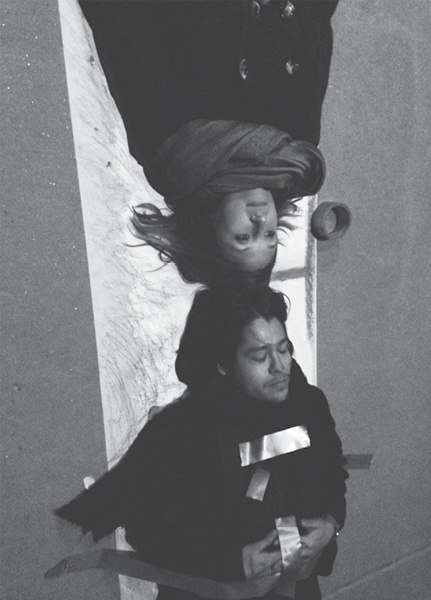
CONVERSING UNDER A BLANKET WITH A PATCH OF SKY STUCK IN A MIRROR
first performed on November 8, 2014
The perimeters of Madelife Art Gallery, Boulder, CO
performed once in 2014
DREAM TIGERS / HANNAH KEZEMA, ANGEL DOMINGUEZ
Boulder, CO
109581763d109581763r109581763e109581763a109581763m109581763t109581763i109581763g109581763e109581763r109581763s109581763s109581763s109581763@109581763g109581763m109581763a109581763i109581763l109581763.109581763c109581763o109581763m
CONVERSING UNDER A BLANKET WITH A PATCH OF SKY STUCK IN A MIRROR
DREAM TIGERS / HANNAH KEZEMA, ANGEL DOMINGUEZ
DREAM TIGERS sought to perform a conversation of failure within the context of the 2014 Failure Festival curated by HOARDED STUFF, who said of FF: “This is a celebration and an acknowledgment of the fact that when things inevitably don’t go as we plan, somehow, we must adapt.” We learned to adapt.
In preparing for the performance, we realized that the performance itself was in a continuous state of preparation. In this way we never began. We faced the paradox of the plan: how does one prepare to fail? Furthermore, how does one perform failure?
We set out to perform for three hours (the length of one festival night); the actual duration became closer to five hours in total. Recordings of previous conversations of failure were to play continuously throughout the performance. The disembodied voices became a prop like object. On the day of the festival, we were informed that we could no longer hold the space in the parking lot. This failure would precipitate the nature of the rest of the performance as a series of trials and errors. By eliminating that space, everything became our space.
Every thirty minutes a timer would go off and be restarted. We would announce “DREAM TIGERS WILL BEGIN IN 30 MINUTES,” while writing these words in charcoal on sheets of butcher paper. We would get undressed and redressed in front of mirrors. We became acutely aware of time within our bodies: it was only through duration and repetition that we were able to predict when the timer would go off. We utilized a table with wheels—this meant that the demarcations of time were also demarcations of space. Time affected our mobility. For each increment, we mapped out a “station” on the periphery of the Madelife building where we would attempt to trace our shadows in charcoal: one of us would hold a floodlight while the other attempted to trace their silhouette.
The audience members initially participated before becoming the directive force of the performance. They decided our props were their props; they decided our bodies were props. The conversational aspect of the performance was abandoned in favor of direct interaction. A failure to be silent allowed the performance a voice of its own. In the end the performance performed us. The performance of failure and planning to fail inevitably invites more failure. As if the performance could exist both inside and outside of a beginning, in a perpetual state of becoming.